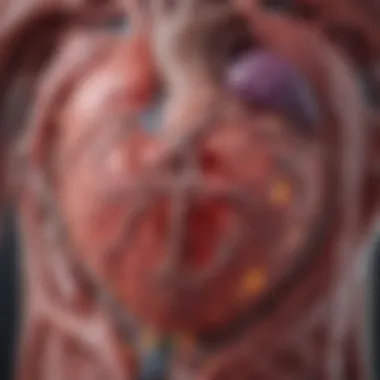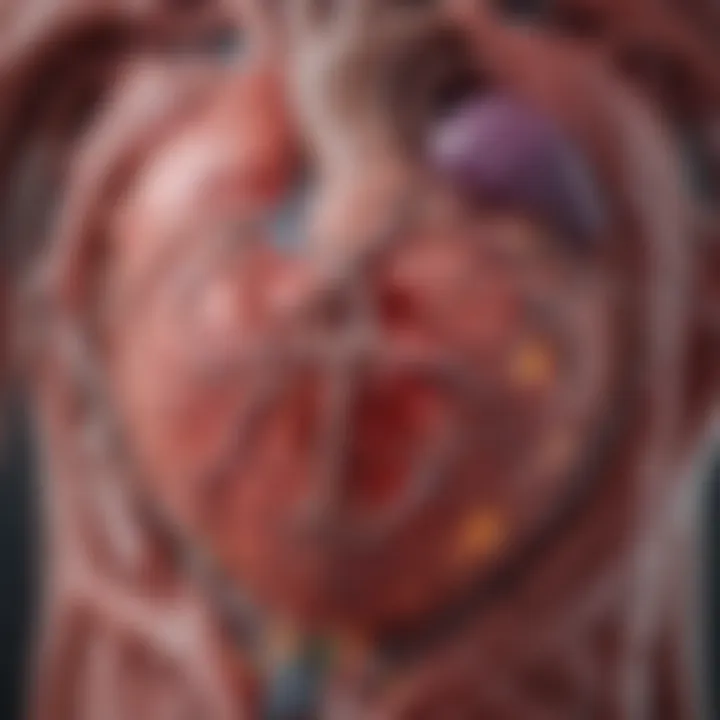Understanding Cardiac Amyloidosis Diagnosis


Intro
Cardiac amyloidosis is a challenging condition that impacts the heart’s function significantly. Recognizing this disease early is critical to improving patient outcomes. This article provides a detailed narrative on how to navigate the diagnostic landscape of cardiac amyloidosis, offering insights into the clinical evaluation, imaging modalities, tests, and genetic assessment involved in the process. A thorough understanding is required to refine diagnostic strategies, especially considering the overlap of symptoms with other cardiac conditions.
Research Overview
Understanding the complexities of cardiac amyloidosis through research is essential to enhancing diagnosis and treatment pathways.
Key Findings
- Early identification of cardiac amyloidosis can reduce morbidity and mortality rates.
- The integration of advanced imaging techniques, such as cardiac MRI and echocardiography, improves diagnostic accuracy.
- Genetic testing is becoming increasingly valuable in determining hereditary forms of the disease.
Study Methodology
Research in this area often relies on a multifaceted approach to diagnosis. Studies typically include:
- Retrospective analysis of patient records.
- Comparative studies between patients with amyloidosis and other heart diseases.
- Evaluation of advanced imaging techniques and their performance metrics.
Data collected aids in identifying patterns that clinicians can use to recognize cardiac amyloidosis at earlier stages.
Background and Context
Understanding the history and evolution of cardiac amyloidosis can provide substantial context for current practices in diagnosis.
Historical Background
Cardiac amyloidosis was first recognized in the early 20th century, with significant advancements occurring in the subsequent decades. Identification of amyloid deposits via biopsy laid the groundwork for further research on systemic amyloidosis and specifically cardiac involvement.
Current Trends in the Field
In recent years, there has been increased awareness and research focus on cardiac amyloidosis. Clinicians are adopting more comprehensive diagnostic frameworks that include:
- Clinical evaluation of symptoms such as heart failure and arrhythmias.
- Utilization of targeted imaging techniques that allow for better visualization of amyloid deposits.
- Growing acceptance of genetic testing to confirm diagnosis and determine the type of amyloidosis.
The evolving approach signifies a shift towards precision medicine, where tailored treatments can be applied based on individual patient profiles.
Intro to Cardiac Amyloidosis
Cardiac amyloidosis is an increasingly important area of study in cardiovascular medicine. This condition involves the abnormal accumulation of amyloid proteins in heart tissue, leading to progressive heart dysfunction. Understanding cardiac amyloidosis is pivotal for several reasons. First, it can significantly affect the quality of life of patients. The symptoms can be subtle but debilitating, often leading to misdiagnosis or delayed treatment. Second, the condition can easily be overlooked because its symptoms may resemble those of more common heart diseases, which is why a clear understanding of its unique characteristics is essential for medical practitioners.
In this article, we will explore how the diagnosis of cardiac amyloidosis can be approached through various methodologies. This includes clinical evaluations, imaging techniques, and laboratory tests. The potential benefits of recognizing this condition early cannot be understated, as prompt diagnosis can lead to targeted therapies that may improve patient outcomes.
Overview of Cardiac Amyloidosis
Cardiac amyloidosis is a type of restrictive cardiomyopathy, wherein amyloid deposits disrupt the normal architecture and function of the heart. The amyloid proteins, which can originate from various sources, lead to impaired cardiac output, arrhythmias, and heart failure. There are different forms of this condition, including AL amyloidosis, which is related to plasma cell disorders, and ATTR amyloidosis, which can be hereditary or wild-type.
The clinical presentations of cardiac amyloidosis can vary widely. Some patients may present with heart failure, while others may have isolated conduction abnormalities. Thus, understanding the range of symptoms associated with this condition is crucial for proper diagnosis. Early detection often involves a high index of suspicion, especially in older adults or those with certain risk factors.
Significance of Early Diagnosis
Early diagnosis of cardiac amyloidosis leads to better management and treatment outcomes. Recognizing the disorder promptly allows healthcare providers to initiate appropriate therapies quickly. This can include medications that manage heart failure symptoms, as well as treatments targeting the underlying amyloidosis, such as chemotherapy for AL amyloidosis or novel therapies for ATTR amyloidosis.
Moreover, early identification can prevent complications arising from congestive heart failure, which can be fatal if left untreated. Timely recognition can also improve the patient's quality of life and reduce healthcare costs associated with advanced disease management. Misdiagnosis or delays in treatment may result in unnecessary interventions or poorer prognosis for patients.
Clinical Presentation of Cardiovascular Symptoms
The clinical presentation of cardiovascular symptoms is essential for understanding cardiac amyloidosis. Symptoms often manifest subtly, complicating early recognition. Identifying these symptoms plays a critical role in timely diagnosis and management. This section explores common symptoms and the differentiation of cardiac amyloidosis from other cardiovascular conditions.
Common Symptoms of Cardiac Amyloidosis
Cardiac amyloidosis typically presents with a range of symptoms that can be nonspecific. These include:
- Fatigue: Patients often report significant fatigue, which may be mistaken for normal aging or other non-cardiac conditions.
- Shortness of Breath: Dyspnea on exertion is common due to heart dysfunction.
- Swelling: Peripheral edema can occur, resulting from heart failure or fluid retention.
- Palpitations: Abnormal heart rhythms may be noted, affecting overall sense of well-being.
Recognizing these symptoms allows healthcare providers to prioritize further diagnostic steps.
Differential Diagnosis
Differentiating cardiac amyloidosis from other conditions is crucial for correct diagnosis. Misinterpretation can lead to inappropriate management strategies.
Heart Failure
Heart failure is a major component of the differential diagnosis. It encompasses a variety of etiologies, including ischemia and hypertensive heart disease. The key characteristic of heart failure is the heart's inability to pump sufficiently, leading to symptoms like fatigue and dyspnea. Here, differentiating features come into play, as cardiac amyloidosis may present with a unique pattern of elevated echocardiographic parameters. The fluid retention observed in heart failure can obscure the amyloid-related dysfunction, making accurate diagnosis challenging, yet necessary for appropriate treatment.


Valvular Heart Disease
Valvular heart disease involves the malfunction of heart valves, commonly presenting with similar symptoms. The essential aspect is that this condition often leads to obstruction or regurgitation. The key characteristic includes a specific sound detected during auscultation. In this context, recognizing the distinct patterns in echocardiography becomes vital. The overlap of symptoms can mislead diagnosis, emphasizing the need for targeted imaging.
Hypertrophic Cardiomyopathy
Hypertrophic cardiomyopathy is another significant condition to consider. This genetic disorder causes thickened heart muscle, leading to obstructive symptoms. The most notable feature is the presence of a characteristic septal thickening observed via imaging. Awareness of its genetic basis also aids in risk assessment. However, distinguishing whether a thickened heart muscle is due to hypertrophy or amyloid deposition can be complex. Misdiagnosis can result in treatment delay, thus highlighting the importance of accurate and comprehensive diagnostic testing.
Accurate identification of these conditions is crucial. Providers must consider clinical history and suggest appropriate referrals based on symptoms presented.
The Importance of Clinical History
Clinical history is a key element in the diagnosis of cardiac amyloidosis. It provides vital context for understanding a patient's symptoms, risk factors, and possible familial connections. Clinicians can piece together an accurate diagnosis by reviewing a patient's medical, familial, and lifestyle history. This thorough investigation often highlights patterns that could otherwise go unnoticed in isolated assessments.
An important benefit lies in the identification of risk factors. Certain conditions, such as chronic inflammatory diseases or plasma cell disorders, can increase the likelihood of amyloidosis. By carefully documenting these factors, healthcare providers can prioritize diagnostic tests and avoid unnecessary procedures. Furthermore, a comprehensive clinical history helps guide interpretation of the results from clinical examinations, laboratory tests, and imaging studies.
The clinical history not only helps in recognizing symptoms associated with cardiac amyloidosis but also plays a role in distinguishing the condition from other cardiac diseases. Symptom overlap with heart failure, valvular heart disease, or hypertrophic cardiomyopathy can mislead practitioners. A detailed understanding of the patient’s past allows for differential diagnosis that may save valuable time and resources.
Overall, the clinical history serves as a foundational element. Through a systematic approach, physicians can navigate complexities that a single diagnostic test may not unveil.
Effective diagnosis requires comprehensive clinical history. This is paramount, as overlooking it may lead to significant diagnostic errors, affecting patient outcomes.
Identifying Risk Factors
When assessing a patient for cardiac amyloidosis, identifying risk factors is critical. Various elements can predispose individuals to this condition, and a well-documented clinical history can reveal them. Age is a significant factor, as the disease often occurs in individuals over 60. Furthermore, specific chronic disorders like rheumatoid arthritis or familial Mediterranean fever can heighten risk.
Another aspect includes lifestyle choices. Factors such as obesity and diabetes mellitus have associations with amyloidosis. Documentation of these elements is crucial for comprehensive patient evaluation.
In addition, a patient’s medication history may yield insights. Certain drugs can influence the development of amyloidosis, thus warranting a keen review.
Familial Connection and Genetic Factors
Familial connections play an important role in diagnosing cardiac amyloidosis. Some forms, like transthyretin amyloidosis, are hereditary. Recognizing a family history of amyloidosis can streamline the testing process for those at risk.
Genetic testing has been increasingly emphasized to understand specific amyloidosis types. When considering genetic testing, age, symptoms, and family history are key parameters. This proactive screening can help diagnose asymptomatic individuals who may later develop cardiac involvement. It also prepares healthcare providers to discuss management strategies early on.
Overall, understanding these familial and genetic factors enriches clinical history. The interplay between a patient's past and the potential development of cardiac amyloidosis guides clinicians in delivering timely and tailored healthcare. By prioritizing comprehensive clinical history and recognizing these connections, practitioners can substantially improve diagnostic accuracy and patient outcomes.
Physical Examination Findings
The examination of a patient with suspected cardiac amyloidosis is essential. Physical findings can provide useful clues towards an accurate diagnosis. These findings may not be specific for cardiac amyloidosis but can guide further investigation. An experienced clinician knows that careful inspection and assessment during a physical exam can lead to critical insights. This section explores the significant aspects of physical examination findings in diagnosing cardiac amyloidosis.
Signs of Heart Failure
Recognizing the signs of heart failure is crucial in evaluating a patient with possible cardiac amyloidosis. Common indicators include:
- Edema: Patients often present with swelling, especially in the lower extremities. This is due to fluid retention caused by reduced heart function.
- Ascites: Fluid accumulation in the abdominal cavity may occur, leading to discomfort and abdominal swelling. It is indicative of right-sided heart failure, a common manifestation in advanced cases.
- Jugular Venous Distention (JVD): Elevated jugular veins can signal increased central venous pressure. This finding is often seen in heart failure, pointing to circulatory issues caused by amyloid infiltration.
- Cardiomegaly: Upon palpation, the heart may feel enlarged. Cardiac amyloidosis typically causes thickening of the heart walls, affecting its overall function.
Identifying these signs early can shine a light on the condition’s progression and severity. While these signs may not confirm cardiac amyloidosis, they lead to necessary tests to explore the diagnosis further.
Auscultation Findings
Auscultation can reveal important heart sounds and murmurs that provide insight into cardiac function. Key findings include:
- Diastolic Dysfunction: In cases of cardiac amyloidosis, the stiffening of heart muscle due to amyloid deposits can cause diastolic dysfunction. This may be evident as a characteristic third heart sound (S3).
- Murmurs: Auscultation might reveal new murmurs, particularly mitral regurgitation or aortic stenosis, resulting from structural changes in the heart due to amyloid deposition.
- Pericardial Rub: If pericardial effusion is present, a friction rub can sometimes be heard, indicating inflammation of the pericardial sac.
These auscultation findings are critical in shaping a preliminary understanding of the patient’s cardiac status. They guide providers in formulating a differential diagnosis.
Effective physical examination is a foundational skill in clinical practice. Understanding the significance of what one hears and sees during this phase can lead to prompt intervention and better patient outcomes.
Laboratory Investigations
Laboratory investigations play a vital role in the diagnosis of cardiac amyloidosis. These tests provide essential data regarding the presence of biomarkers and various physiological markers that can indicate amyloid deposits in cardiac tissues. The ability to obtain significant information from routine blood tests offers an initial approach to understanding a patient’s condition. Furthermore, these investigations help to differentiate cardiac amyloidosis from other similar cardiovascular diseases, enabling healthcare professionals to develop an effective management strategy.
Biomarkers for Amyloidosis
NT-proBNP
N-terminal pro b-type Natriuretic Peptide, commonly known as NT-proBNP, is a crucial biomarker used in the evaluation of cardiac amyloidosis. It reflects left ventricular dysfunction, an essential aspect of the condition. The elevation of NT-proBNP levels indicates that the heart is under stress, which is particularly relevant in the setting of amyloid deposition.
One of the key characteristics of NT-proBNP is its ability to facilitate early detection of heart failure. This makes it a valuable tool in the initial assessment of patients suspected of having cardiac amyloidosis. The unique feature of NT-proBNP is its stability in serum samples, allowing for accurate measurements over time.
Despite its benefits, NT-proBNP’s interpretation must consider other factors, such as renal function and other cardiac pathologies, which can influence its levels. Yet, its advantages in distinguishing heart failure from other causes of dyspnea are significant for this article.


Troponins
Troponins, specifically cardiac troponin T and I, are also pivotal biomarkers in diagnosing cardiac amyloidosis. They are the gold standard for identifying myocardial injury. The presence of elevated troponin levels indicates damage to the cardiac muscle, which may arise from amyloid deposits impairing myocardial function.
The most notable characteristic of troponins is their high specificity and sensitivity for cardiac damage. This makes them invaluable in the diagnostic process. Additionally, troponins can provide insight into the degree of myocardial injury, offering a glimpse into disease progression.
However, like NT-proBNP, troponin levels can be influenced by various factors. For instance, their elevation may also occur in other cardiac conditions, posing a challenge in interpretation. Nonetheless, their importance in the context of cardiac amyloidosis cannot be understated, as they enhance the understanding of myocardial involvement in the disease.
Routine Blood Tests
Routine blood tests are standard practices in clinical medicine and serve as a foundational step in diagnosing cardiac amyloidosis. These tests typically include a complete blood count, renal function tests, and electrolyte panels, among others. The results shed light on overall health status and can indicate potential complications arising from the disease, such as renal dysfunction or anemia, which are often associated with amyloidosis.
In particular, assessing renal function is crucial as amyloid may deposit in the kidneys, leading to impairment. Anemia is another common finding associated with this condition and can help physicians in their diagnostic approach. Overall, these routine tests not only assist in the identification of cardiac amyloidosis but also help to evaluate the extent of the disease and its systemic effects on the body.
Imaging Modalities in Diagnosis
Imaging plays a pivotal role in the diagnosis of cardiac amyloidosis. It provides valuable information about cardiac structure and function, guiding clinicians toward an accurate diagnosis. Different imaging modalities offer unique perspectives on the heart's condition, allowing for a comprehensive understanding of the disease. This section will detail echocardiography techniques and the role of cardiac MRI in diagnosing cardiac amyloidosis.
Echocardiography Techniques
Echocardiography is often the first-line imaging technique used in evaluating suspected cardiac amyloidosis. It provides real-time images of the heart's chambers, walls, and valves, aiding in the assessment of its function and structure.
2D and 3D Echocardiography
2D echocardiography is widely utilized due to its ability to create cross-sectional images of the heart. It allows for the assessment of left ventricular hypertrophy, which is a common finding in cardiac amyloidosis.
One key characteristic of 2D echocardiography is its effectiveness in identifying specific structural changes in the heart. However, it is limited in its capability to provide volumetric data completely. This is where 3D echocardiography comes into play. 3D echocardiography offers a more comprehensive view of the heart's anatomy and allows for accurate volume measurements. The unique feature of 3D echocardiography lies in its capacity to provide high-resolution images of the heart in real-space, which markedly improves the assessment of valve morphology and function. The major advantage is the enhanced visualization of cardiac structures, but it may require more time and skilled operators.
Strain Imaging
Strain imaging is an advanced echocardiographic technique that assesses the heart's deformation during the cardiac cycle. It measures how the heart muscle changes shape when beating, providing insights into myocardial function. One significant aspect of strain imaging is its sensitivity in detecting subtle changes in cardiac function that may not be apparent with standard echocardiography. This makes it beneficial in diagnosing cardiac amyloidosis, especially in early stages when traditional methods may yield normal results. The unique feature of strain imaging is its ability to quantify myocardial strain and speckle tracking, potentially uncovering the extent of amyloid infiltration. While widely regarded for its advantages, the technique can be limited by operator dependency and the requirement for advanced imaging systems.
Cardiac MRI Role
Cardiac MRI has emerged as an important tool in diagnosing cardiac amyloidosis. It provides high-resolution images and detailed information about tissue characteristics. The primary advantage of cardiac MRI is its ability to assess both cardiac structure and tissue composition, which is crucial for identifying amyloid deposits.
MRI can also evaluate the degree of myocardial fibrosis, which occurs as amyloid infiltrates the heart. A specific sequence called T1 mapping can assess myocardial tissue properties reliably, helping distinguish amyloidosis from other cardiac conditions. However, accessibility and the need for specialized equipment can limit the widespread use of cardiac MRI in some settings.
In summary, imaging modalities are essential in diagnosing cardiac amyloidosis, enabling clinicians to visualize and assess the heart comprehensively.
By integrating the data gathered from echocardiography and cardiac MRI, healthcare professionals can make more informed decisions regarding patient management and treatment.
Nuclear Imaging Techniques
Nuclear imaging plays a vital role in the diagnosis of cardiac amyloidosis. These methods offer unique insights that complement other diagnostic techniques such as echocardiography and MRI. Nuclear imaging is particularly beneficial for detecting amyloid deposits in the heart and assessing the extent of cardiac involvement. In patients suspected of having amyloidosis, these techniques can provide crucial information that influences treatment decisions.
SPECT and PET Scans
Single-photon emission computed tomography (SPECT) and positron emission tomography (PET) are advanced nuclear imaging techniques. SPECT scans use gamma rays to create detailed three-dimensional images of the heart. PET scans track the distribution of a radiotracer, revealing areas of abnormal metabolism associated with amyloid deposition.
Using SPECT or PET can enhance the detection of cardiac amyloidosis by highlighting areas of reduced blood flow or abnormal tracer uptake. This information can indicate the severity of the disease and help differentiate amyloidosis from other forms of heart disease. In a clinical setting, these scans can significantly assist in confirming the diagnosis, particularly when other testing methods yield inconclusive results.
SPECT and PET are instrumental in identifying amyloid involvement, which is crucial for prompt and accurate diagnosis.
Bone Scintigraphy
Bone scintigraphy, also known as bone scan, is another valuable imaging tool in diagnosing cardiac amyloidosis. It relies on radiolabeled compounds that bind to bone tissue, allowing visualization of skeletal and myocardial uptake patterns.
In patients with cardiac amyloidosis, a specific type of bone scintigraphy can show distinct patterns, particularly with technetium-99m-labeled radiotracers. This test helps discern between different types of amyloidosis, such as transthyretin amyloidosis (ATTR) and light chain amyloidosis (AL). The imaging outcomes can provide insights into the extent of cardiac amyloid deposition, which is essential for planning treatment strategies.
Additionally, bone scintigraphy is non-invasive and relatively accessible, making it a practical option for evaluating suspected cardiac amyloidosis. This imaging modality not only enhances diagnostic accuracy but also contributes to the overall assessment and monitoring of disease progression.
Overall, nuclear imaging techniques, including SPECT, PET, and bone scintigraphy, offer indispensable contributions to the diagnostic landscape of cardiac amyloidosis. They enable the identification of amyloid deposits, assisting healthcare professionals in delivering tailored management plans.
Histopathological Confirmation
Histopathological confirmation is a critical component in the diagnosis of cardiac amyloidosis. It involves examining tissue samples under a microscope to identify the presence of amyloid deposits. Such confirmation not only solidifies the diagnosis but also helps distinguish between different types of amyloidosis, each requiring specific management strategies. This section emphasizes the necessity of tissue evaluation in defining the disease and tailoring appropriate treatments.
Tissue Biopsy Procedures
Biopsy techniques play a vital role in obtaining the necessary tissue samples for diagnosis. The procedure must be performed with careful consideration of not only the patient's condition but also the specific type of amyloidosis suspected. Proper sampling techniques ensure that the collected tissue is suitable for histological analysis. Typically, the biopsy can be performed on various organ systems, with the heart being a critical area of focus in cardiac amyloidosis diagnosis. The choice often depends on the clinical presentation of the disease and accessibility of tissue.
Types of Biopsy
Endomyocardial Biopsy
Endomyocardial biopsy is a procedure that involves taking a small sample of heart tissue through a catheter inserted into the heart chambers. This technique is particularly important because it allows for direct examination of the cardiac tissue, which is essential for identifying amyloid deposits in situ. The key characteristic of endomyocardial biopsy is its ability to provide real-time information about the heart's condition. It is often considered the gold standard in confirming cardiac amyloidosis due to its specificity and direct approach.


The unique feature of this biopsy type is that it can be performed during cardiac catheterization, minimizing additional risks for the patient. However, there are disadvantages, such as the potential for complications, including bleeding or infection. Moreover, if the amyloid infiltration is patchy, there's a risk that the biopsy may miss affected areas.
Subcutaneous Fat Biopsy
Subcutaneous fat biopsy involves extracting a small sample of fat tissue, usually from the abdominal area. This procedure is less invasive compared to endomyocardial biopsy and is beneficial as it can sometimes yield results that indicate systemic amyloidosis, providing information about the amyloid protein type. The key characteristic of this method is its low risk and ease of access, making it a preferred initial approach in certain cases.
The unique feature here is that this biopsy can demonstrate the presence of amyloid deposits commonly found in AL amyloidosis. It may not be as definitive in confirming cardiac involvement, but it serves as a useful adjunct when cardiac tissue samples are less feasible. Advantages include its minimal invasiveness and quick recovery time; however, it may be less accurate than endomyocardial biopsy for diagnosing cardiac amyloidosis specifically.
Key Point: Both biopsy types serve important roles in confirming cardiac amyloidosis, with unique strengths and limitations that clinicians must consider.
In summary, histopathological confirmation through various biopsy techniques enables accurate diagnosis and better informed treatment plans. Understanding the distinct advantages and disadvantages of each method is crucial for optimal patient outcomes.
Genetic Testing in Cardiac Amyloidosis
Genetic testing plays a significant role in the diagnosis and management of cardiac amyloidosis. It helps to identify specific genetic mutations that contribute to the various forms of this condition. The presence of certain mutations can guide treatment decisions and inform family members about their risk of developing similar issues. This aspect of diagnosis becomes even more essential when considering the hereditary nature of some types of amyloidosis, notably transthyretin amyloidosis (ATTR) and light chain amyloidosis (AL). Understanding when to consider genetic testing can be critical in tailoring patient care.
When to Consider Genetic Testing
Genetic testing should be considered in patients with a clear clinical diagnosis of cardiac amyloidosis, particularly if they present symptoms at a younger age or have a family history of amyloidosis or related cardiac conditions. Moreover, those displaying atypical features of myocardial disease that do not correspond with common cardiac problems may benefit from such testing. Here are a few key scenarios:
- Early Onset Symptoms: Patients under the age of 50 with unexplained heart failure symptoms.
- Familial History: Individuals with a known family history of amyloidosis or other systemic diseases.
- Atypical Clinical Presentation: Cases where the symptoms do not clearly align with other forms of cardiac disease.
Identifying these parameters helps increase the likelihood of timely and accurate diagnosis, ultimately leading to better management options for the patient.
Testing for Specific Types of Amyloidosis
AL Amyloidosis
AL amyloidosis, caused by the deposition of light chains produced by plasma cells, is a prevalent type of amyloidosis affecting the heart. In cardiac amyloidosis, this form is particularly significant due to its potential reversibility with treatment. Early detection is vital, as heart involvement can lead to severe dysfunction and increased morbidity. Genetic testing can pinpoint whether the amyloidosis is of the AL type, enabling a specific treatment pathway. The simplicity of the test and its non-invasive nature make it a popular choice among clinicians to diagnose AL amyloidosis.
ATTR Amyloidosis
ATTR amyloidosis arises from mutations in the transthyretin protein. This form can be hereditary or acquired, with distinct implications for treatment and management. Genetic testing for ATTR is crucial for identifying familial cases, especially among patients who exhibit cardiac involvement. These individuals may benefit from therapies designed to stabilize or inhibit the amyloid formation process. The ability to distinguish between hereditary ATTR amyloidosis and wild-type (age-related) forms is essential for prognosis and therapy decision-making. The test's reliability in confirming the diagnosis makes it a beneficial tool in this article, as it allows targeted therapeutic interventions.
Challenges in Diagnosis
Diagnosing cardiac amyloidosis presents significant challenges that can lead to mismanagement and poor patient outcomes. Understanding these challenges is crucial for medical professionals to refine their approach and improve diagnosis accuracy. This section delves into two primary issues: misdiagnosis and delays, and the overlap with other cardiac diseases, both of which can complicate the identification of cardiac amyloidosis.
Misdiagnosis and Delays
Misdiagnosis is a common issue in cardiac amyloidosis. Symptoms, such as shortness of breath and fatigue, are often misattributed to more prevalent conditions like heart failure or hypertensive heart disease. This diversion can contribute to significant delays in initiating the appropriate treatment.
"Timely diagnosis of cardiac amyloidosis is essential; otherwise, patients can progress to severe complications."
Physicians must maintain a high index of suspicion for cardiac amyloidosis, especially in older adults presenting with unexplained heart failure. Diagnostic criteria need to be established promptly. A failure to recognize the signs and symptoms can lead to the progression of cardiac dysfunction, ultimately affecting the prognosis.
Additionally, advanced imaging and testing may be necessary but are not always immediately accessible, causing delays. If a patient does not receive the right tests or evaluations, the chance of accurate diagnosis diminishes significantly. Awareness training for healthcare providers about the nuances of this condition is essential in minimizing misdiagnosis.
Overlap with Other Cardiac Diseases
The clinical presentation of cardiac amyloidosis closely resembles that of various other cardiac conditions. This overlap creates a considerable challenge for physicians tasked with formulating a precise diagnosis. Conditions such as hypertrophic cardiomyopathy or valvular heart disease share similar symptoms, resembling the manifestations of cardiac amyloidosis, which often leads to confusion.
- Key issues include:
- Differentiation of Symptoms: Symptoms like dyspnea and arrhythmias are not unique to cardiac amyloidosis. The clinician must dissect each symptom carefully and contextualize it within the patient’s overall clinical picture.
- Echocardiographic Findings: Echocardiography may reveal left ventricular hypertrophy, a finding that can occur in many cardiac diseases, further clouding the diagnostic process.
This overlap demands a multifaceted diagnostic approach. Comprehensive testing, including advanced imaging and biomarker analysis, can help distinguish cardiac amyloidosis from other diseases. It is incumbent upon the healthcare system to provide adequate resources and training for providers to navigate these challenges effectively.
Finale
In the realm of cardiac amyloidosis, coming to a clear and accurate diagnosis is paramount. The complexity of this disorder requires a thorough understanding of various diagnostic modalities and protocols to ensure effective management. By summarizing the diagnostic approach in this article, we reinforce the importance of an integrative strategy that encompasses clinical history, physical examination, laboratory investigations, imaging techniques, and genetic testing. Each component plays a critical role in recognizing the disease early, which can directly influence patient outcomes.
Summarizing the Diagnostic Approach
The diagnostic journey for cardiac amyloidosis is multifaceted. Clinicians must start by taking a detailed clinical history that considers symptoms and risk factors. Next, a physical examination can uncover signs indicative of heart failure or abnormal heart sounds.
Various laboratory tests, like NT-proBNP and troponins, provide essential biomarkers that aid in identifying amyloidosis. Imaging modalities such as echocardiography and cardiac MRI visualizes structural changes in the heart, while nuclear imaging plays a crucial role as well. The integration of these methods allows for a comprehensive assessment of the patient's condition.
Key Steps in the Diagnostic Approach:
- Clinical History and Symptoms
- Physical Examination
- Biomarkers in Laboratory Tests
- Echocardiography and MRI
- Specialized Nuclear Imaging
Ultimately, each step in the diagnostic approach is interlinked and vital. Differences in amyloidosis types, such as AL and ATTR, necessitate understanding how to interpret results and apply them to diagnosis and management. Recognition and appropriate identification can dramatically improve treatment efficacy and patient quality of life.
Future Directions in Research
As the understanding of cardiac amyloidosis evolves, future research holds promise for sharper diagnostic techniques and innovative treatment options. Areas that require further exploration include:
- Novel Biomarkers: The identification of more specific biomarkers could significantly enhance diagnostic accuracy.
- Advanced Imaging Techniques: Development in imaging modalities may provide better visualization and characterization of amyloid deposits.
- Genomic Studies: Research into the genetic basis of amyloidosis might yield insights into its pathophysiology and pave the way for precision medicine approaches.
Furthermore, interdisciplinary collaboration among cardiologists, geneticists, and researchers is crucial. This collaboration can lead to larger studies and trials that investigate the efficacy of differing treatment strategies tailored to distinct amyloidosis types.







